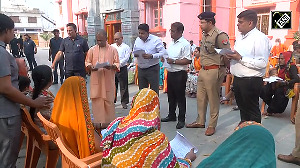Scientists have created a new system that will enable them to improve computer-generated tsunami models that can predict the height and speed of tsunamis in risk areas of the world.
The new model, the scientists claim, can identify coasts likely to be hit and the safe areas that people can flee to.
The data has been collected by an international team of 27 scientists comprising world's foremost seismologists, geophysicists, biologists, seabed visualisation experts and tsunami modelers.
The team spent 17 days exploring the seafloor off the coast of Sumatra, the epicentre of the December 26, 2004 tsunami.
"The whole purpose of the expedition was to study the causes and fast-fading evidence of the last year's tsunami and improve the existing model to minimise loss of life and property from tsunamis," said the sole Indian on the expedition Dr Baban Ingole, a marine biologist from National Institute of Oceanography, Goa.
The expedition, constituted early in January and funded by Discovery television channel, began its journey from the tourist destination Phi Phi in Thailand, in May.
The expedition, backed by new geological evidence, revealed that it was a sea-floor uplift from the 9.2 magnitude earthquake and not a giant underwater landslide that caused the tsunami.
"The great Sumatra earthquake lifted the entire chain of islands out of the water as high as 10 feet. Though ten feet-high water is not capable of causing such destruction, the fact is that the tsunami was a hundred miles from front to back, carrying 200 trillion tonnes of water and was traveling at over 500 metres per hour," Ingole said.
The orphans the waves left behind
"As it neared land, entering shallow water, it slowed. But the back of the wave, which was a hundred miles behind was still traveling at the same speed. The rear end caught up, compressing the wave into a vertical wall of water up to 120 feet high," he added.
The team on board the ship The Performer stood directly above the fault line -- the vast undersea chain of mountains in the Indian Ocean -- using the Global Positioning System.
The crew conducted their research from the surface using a remote-operated vehicle that transmitted video images back to the surface.
India's tsunami response quicker than the rest
Besides capturing the entire sequence of events that caused the tsunami, the expedition recorded hitherto unknown data and information.
Tsunami expert Stefan Grilli has found out that only half of the 1600-mile fault line was ruptured and that the other half could break anytime.
The scientists also believe that an identical thrust lies less than 50 miles off the northwest coast of America and the entire 500 miles of US coastline is prone to a similar disaster.
Researchers develop tsunami atlas
'The new computer model from the expedition predicts that the tsunami that will hit the US could be a far more deadly wave and it could strike within less than 15 minutes of a warning. 500,000 people living on the coast between northern California and Vancouver and British Columbia are at a great risk,' a scientist said.
The expedition and their findings will be aired in a programme on Discovery channel coinciding with the anniversary of one of the world's greatest disasters that hit about 13 nations.
"We can't control natural disasters like earthquakes, volcanoes and hurricanes. But we just hope to gather information and create awareness about them so that people know how to protect themselves in the wake of such an event," said Ingole.





 © 2025
© 2025